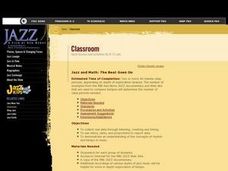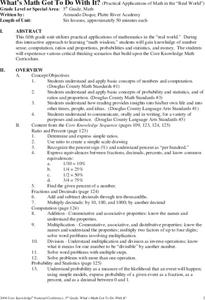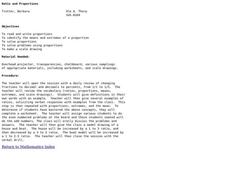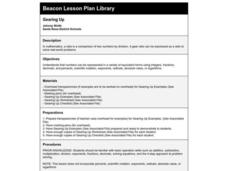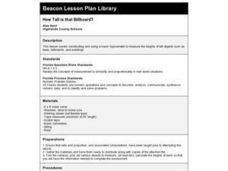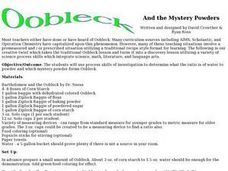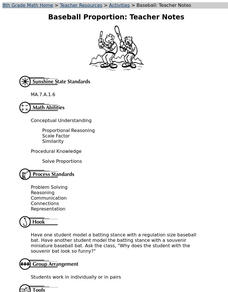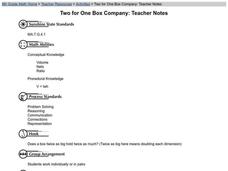Curated OER
Tennis Triangle
Learners calculate the height of a tree or flagpole. They measure the shadow of the tree or flagpole and the length of a shadow of a meterstick. Using similar triangles, calculate the heigh. Devise two additional ways in which to measure...
Curated OER
Playing with Money (From the New Zealand Point of View)
Students explore the exchange rates for five countries. They identify the units of currency of a number of countries. Students convert money amounts accurately from New Zealand dollars to another currency. They graph currency...
Curated OER
Springy Legs
Fifth graders measure their body height and the height they can jump. They use these measurements in forms of ratios, fractions and decimals to describe their Springy Legs Factors (SLF). Students compare their SLFs to other people's...
Curated OER
The Patchwork Quilt and Something From Nothing
Students listen to the teacher read the first 26 pages of the story, Something From Nothing, and discuss what predicting means, Students predict how Joesph might remember what his grandfather made him, now that the button is gone. They...
Curated OER
Golden Connections
Learners determine the ratio of pairs of consecutive terms in the Fibonacci Sequence. Using four different colors, they create a golden rectangle in either two or three dimensions. They use photographs to create two collages using...
Curated OER
Landmark Restoration Project-Scale Model Measurements
Learners work in cooperative groups to find the actual measurements of an historical building/landmark. Then they use ratio and proportion to figure the measurements that might be used to create a scale model of the structure.
Curated OER
Using Variables And Ratios To Get You in the Right Gear
Students examine the use of variable and ratio in everyday situations including figuring out the gear ratios for the gears on a 12 speed bike. They use the bubble sort technique to write a computer program which will determine the...
Curated OER
Jazz and Math: The Beat Goes On
Students collect real data through listening, counting and timing jazz pieces.They use ratios, rates, and proportions to report collected data and demonstrate an understanding of the concepts of rhythm and tempo in music.
Curated OER
Least Squares Fit Line
Pupils estimate the least squares fit line for a set of data. They understand error involved in least square fit lines. They solve application problems using least square fit lines.
Curated OER
Genes Count
Students view a video that reviews Mendelian genetics. They discuss the Hardy-Weinberg Law and use Popsicle sticks to simulate genetic variations and ratios in offspring.
Curated OER
Sun, Shadows, Surface Structure...and the Face on Mars
Students use light and shadow information to make inferences regarding the three dimensional shapes of specific objects photographed on the surface of Mars. Limitations of the of the data provided are discussed and entries made into the...
Curated OER
A Planet Full of Animals
Students explore a variety of animals that live on our planet. The shapes, sizes, colors, movements, and coverings of the animals are observed. The similarities and differences in the animals are grouped according to common traits.
Curated OER
What's Math Got To Do With It?
Students explore numbers, computation, ratios, proportions, probabilities, statistics, and money in this six lessons unit. Practical applications in the real world are emphasized through an interactive approach to math in these lessons.
Curated OER
How Big Is a Piece of PI?
Students explore the ratio of circumference to diameter in order to estimate a value for pi.
Curated OER
All About Ratios
Students investigate the use of multiplication and division of whole numbers to solve problems including equivalent ratios and rates.
Curated OER
Ratio and Proportions
Students explore the means and extremes of a proportion, the how to make a scale drawing.
Curated OER
A Recipe For Success
Sixth graders explore a relevant application of ratios and proportions. They apply this concept through guided practice and interactive feedback.
Curated OER
Oobleck and the Mystery Powders
Students listen to the book, "Oobleck," by Dr. Suess before experimenting with mystery powders. They determine the proper ratio of powder to liquid to make the Oobleck.
Curated OER
Baseball Proportion
Eighth graders measure regular baseball bats and souvenir bats in centimeters. They determine how tall a person would be to be in proportion to the souvenir bat, create a poster depicting the person, and explain the proportional...
Curated OER
Shaquille O'Neal Hand/Foot Span
Eighth graders measure foot length and hand span in this experiment to determine the ratio. They apply the ratio to determine Shaquille O'Neal's hand span if given his shoe size.
Curated OER
Two for One Box Company
Eighth graders experiment to decide if a box that is twice as big holds twice a much. They work the concept of volume and how changing dimensions affect it.
Curated OER
Does More Wins Mean More Fans At The Ballpark?
Students, after getting information from the past baseball season off the Internet, calculate an attendance-to-win ratio for each of the 28 major league teams and then study the results to see if winning always leads to good attendance.









